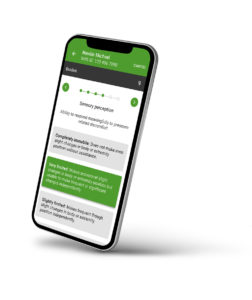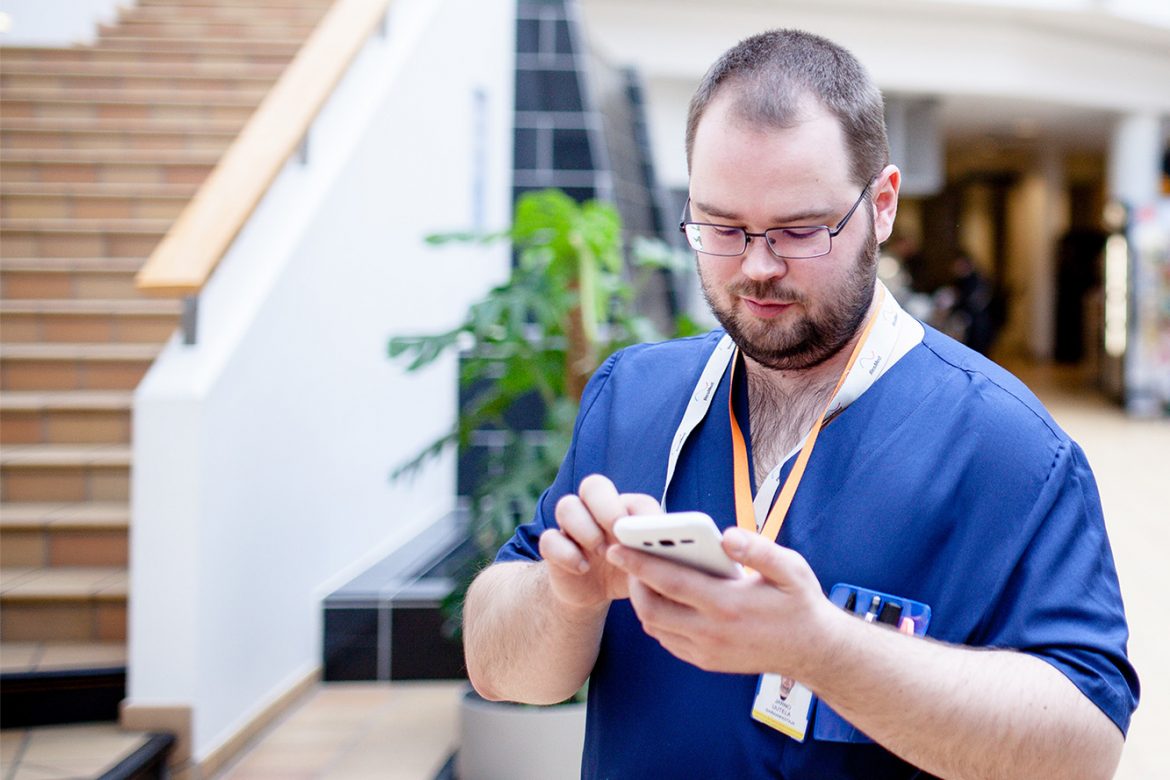As the patient risk status can be assessed quickly and easily, it is also assessed more frequently.
Patient risk assessments have increased in many Finnish hospitals after the introduction of mobile forms. Regular risk assessments have made earlier interventions possible in potential incidents and causes of patient injury, reducing the probability of the risks and the resulting costs.
Previous approach problematic for care work
In Finland, the most commonly used risk assessment tools are the Braden Scale for Predicting Pressure Ulcer Risk, NRS 2002 for nutritional risk screening, and FRAT for fall risk assessment. The frequency of their use has often left much to be desired, as the paper method is labour-intensive and open to interpretation.
Kristiina Holm, who works as a nurse at Satasairaala, says that they have previously carried out risk assessments manually, such as Braden scale and NRS 2002 reviews.
– We had to interpret a laminated table and perform mental arithmetic to get the totals. We wrote down the risk scores on paper, which were then stuffed into a folder in the office. Risk assessments were open to interpretation and information was difficult to find later, it was not practical at all, says Holm.
Mobile forms help nurses
The mobile risk assessment feature developed by Medanets together with its customers makes risk assessments straightforward: it can calculate any risk score* supported by the Electronic Health Record (EHR) interactively, display instructions for the nurse immediately, and document the risk score in the patient’s record in the EHR. The score forms and instructions can be modified to suit the needs of the hospital or unit.
 The mobile feature is in use at seven Finnish hospitals:
The mobile feature is in use at seven Finnish hospitals:
- Tampere University Hospital
- Central Finland Central Hospital
- Seinäjoki Central Hospital
- Raahe Hospital
- Satasairaala
- Kainuu Central Hospital
- Päijät-Häme Central Hospital
Nurse Holm says that the introduction of Medanets has made risk assessments a significant part of daily patient care thanks to its ease of use and the guidance provided.
– A clear review of the classification helps the nurse consider the right areas in the patient’s care, such as better nutrition or a new mattress. It guides care without needing extra time – on the contrary, it does away with extra steps. This is a great help in my work, says Holm.
Identifying risks keeps costs in check
Nurses carry smartphones during their other duties, so there is a low barrier to filling out a mobile form. Regular risk assessments help keep patients from harm, which reduces the costs of their care:
- In Finland, pressure ulcers cost over €400 million annually, which is 2-3 % of the national healthcare expenses. Preventive measures could help avoid approximately 95% of pressure ulcers. [1.]
- Inadequate nutrition extends hospital stays by 3-6 days and can even triple the cost of care [2].
- In Finland, the cost of emergency outpatient and hospital care for falling injuries of people over 64 was about €39 million in 2000. The cost is projected to increase to €72 million by 2030. [3.]
Previously, according to Holm, risk assessments were carried out for new patients coming to the ward and only updated as necessary, if the patient’s status changed. Now a new risk score is logged for each patient every day. The patients benefit from this, as their pressure ulcers can be prevented. Patients have also appreciated the responsiveness.
Satasairaala receives an award for improving the prevention of pressure ulcers
An award was granted this year for the work done by Satasairaala in the prevention of pressure ulcers. After five years of development, Satasairaala has reduced the occurrence of pressure ulcers during patient care by 3.5%.[4.] The average cost of one pressure ulcer is €5,000–6,650. [5]
The risk assessment functionality of the Medanets point-of-care mobile app was adopted by Satasairaala in the spring of 2017, and it is now used by all eleven of the hospital’s wards. At Satasairaala, the Medanets app is used to carry out over 300 Braden risk assessments and over 700 NRS 2002 analyses every month.
I have worked at my current ward in the Heart Unit for two years now, and from what I have seen, no patients have suffered from pressure ulcers at our ward. We are very active Braden users and we respond to situations immediately, which is why we have an excellent track record when it comes to pressure ulcers.
-Kristiina Holm, Nurse, Satasairaala
*Possible to implement for any risk scoring supported by the EHR, e.g. Braden, FRAT, NRS2002, CAM, MNA, BDI21, AUDIT C, Mini-intervention, AUDIT65 and GDS30.
Sources:
[1] Harjumaa, M. 2013. Painehaavat käyvät kalliiksi. Sairaanhoitaja 13, 10.
[2] Karuvuori, A. 2013. Ruoka on nostettu pöydälle. Sairaanhoitaja 12, 16–25.
[3] Piirtola M, ym. 2002. Iäkkäiden kaatumisvammojen akuuttihoidon kustannukset. Suomen Lääkärilehti; 57: 4841–4848.
[4] Satasairaala. 2019. ”Satasairaala palkittiin painehaavojen ehkäisyn kehittämistyöstä”. Haettu osoitteesta: https://www.satasairaala.fi/satasairaala/ajankohtaista/satasairaala-palkittiin-painehaavojen-ehkaisyn-kehittamistyosta. 21.11.2019
[5] Posnet J, Gottrup F, Lundgren H, Saal G. The resource impact of wounds on health-care providers in Europe. J Wound Care 2009
